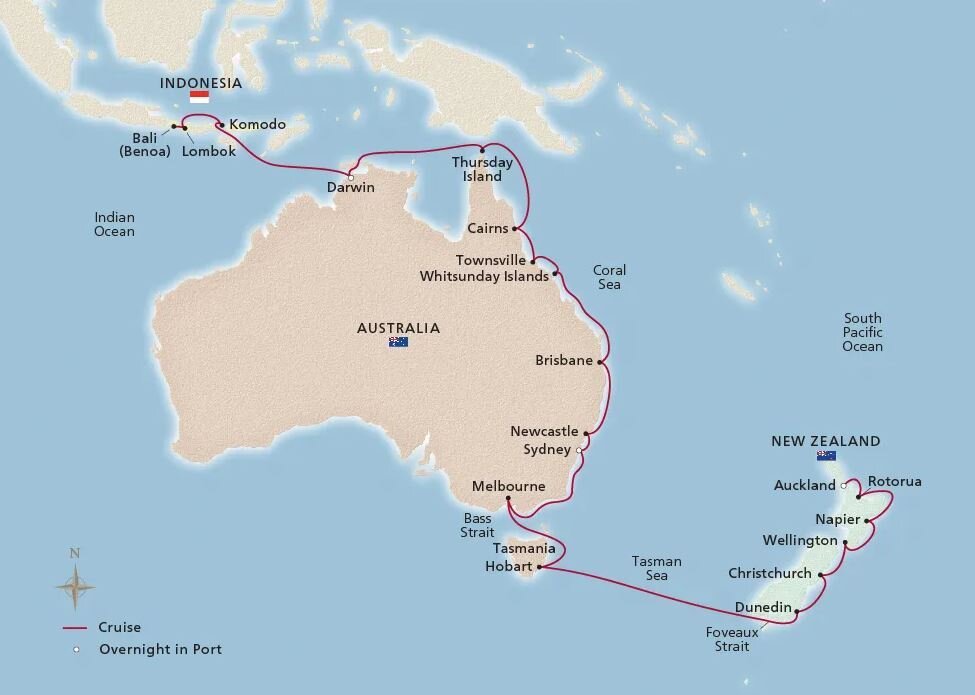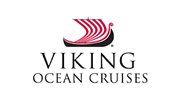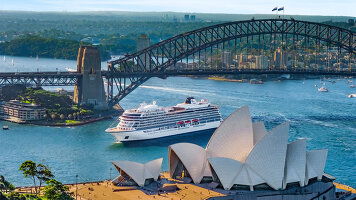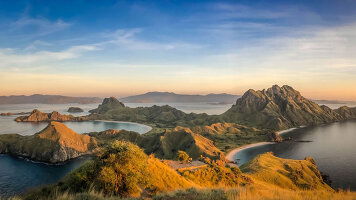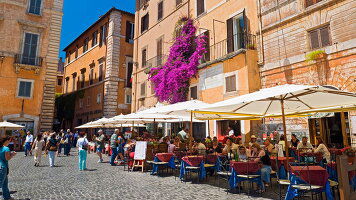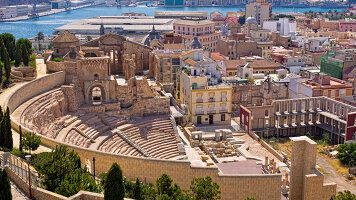Overview
Itinerary
Transfer to your ship and settle into your stateroom. Cultural capital of New Zealand's North Island, Auckland is known as the “City of Sails” for its residents' love of boating. This seafaring city has hosted three America's Cup challenges, and its marinas are brimming with world-class yachts. In tree-lined Albert Park, flower beds and towering palms point the way to a cast-iron central fountain. The neoclassical Auckland War Memorial Museum chronicles the nation's history within its edifice-like walls. The observation deck of the Sky Tower offers breathtaking bird's-eye views of Auckland's cityscape.
Straddling a narrow isthmus on New Zealand's North Island, Auckland enjoys a picturesque setting between two harbors: Waitematā and Manukau. This cosmopolitan city of outdoor enthusiasts is a vibrant marine hub. One of the great pleasures of exploring the city by foot is witnessing countless masts bobbing with the tide at the city's marinas and jet-setting yacht clubs, and marveling at the many full-blown sails as they traverse glittering waters in the distance.
Tauranga, nestled on the Bay of Plenty, is watched over by the dramatic Mt. Maunganui, an extinct volcano that helped shape this spectacular region of white-sand beaches and azure waters. The Māori arrived here in the 13th century, followed by the British 600 years later. Today, the city is home to a thriving cultural scene and stunning vistas of mountains rising from the surrounding waters. Tauranga is best known as the gateway to the bubbling mud pools and thermal fields of Rotorua. The local Māori believe this cauldron-like region to be a gift of fire from the gods.
Napier is an impressive cityscape of art deco architecture often compared to Miami Beach for its splendor. Built after much of the city was destroyed during a 1931 earthquake, the stunning “main street” design and art deco flair combine to create a city unlike any other in the world. The National Aquarium, one of the finest in New Zealand, can be found in Napier. Nearby, Hawke's Bay boasts more than 70 vineyards. The first ones were introduced by French missionaries during the mid-19th century. The city also holds claim as the largest wool center in the Southern Hemisphere.
Wellington, the capital of New Zealand, enjoys a splendid setting and is hailed by many as the “coolest little capital in the world.” Its history is embodied in a rich collection of architecture, from classic weatherboard wooden cottages and the clean lines of art deco to Edwardian and postmodern wonders. The city's neoclassical Parliament House stands out and is listed as a Heritage New Zealand building for its history and cultural significance. The city hosts an array of arts and cultural institutions, including museums, symphonies, ballet and film.
Christchurch is the largest city on New Zealand's South Island. Named after Christ Church College in Oxford by English pilgrims from Canterbury, it retains much of its original British flavor, from the Gothic Revival cathedral to the punting excursion boats on the tranquil Avon River. The city embraces another English tradition: it is home to so many green parks that it has been nicknamed the “Garden City.” Its lush Botanic Gardens ranks among the most important in the world, hosting plants from six continents, a rock garden and a water garden of lilies and irises.
Dunedin and Port Chalmers lie on the 12-mile-long Otago Harbour. At the heart of the city, Dunedin is home to New Zealand's first university, built in 1871. This lively college town is one of the South Island's cultural capitals. Neighboring Port Chalmers has a thriving arts scene, inspired by its setting. Across the water, the distinctive Harbour Cone summit rises on the Otago Peninsula. Together, this unspoiled region is a breathtaking vista of mountains and sea, and home to seals, penguins and seabirds, including the only mainland colony of albatross in the world.
The narrow Foveaux Strait separates New Zealand's South Island from Stewart Island, also known as Rakiura (or 'the Land of Growing Skies') after its Māori name. The small town of Bluff is the South Island's southernmost settlement and is dominated by Bluff Hill to its west. With a permanent population of less than 400 people, Stewart Island is New Zealand's third-largest island, ringed with bays and blanketed with lush forests.
“Cross the ditch” as you sail today, a term coined to refer to a voyage on the Tasman Sea, just as many Americans and Europeans refer to a trans-Atlantic journey as “hopping the pond.” Admire the views as you sail today and enjoy an al fresco dining experience. The Aquavit Terrace serves a range of International fare and casual dining favorites, as well as a range of superb cocktails inspired by our destinations.
Tasmania, Australia's smallest state, was named after Dutch explorer Abel Tasman. Its capital, Hobart, was founded as a penal colony for some 300 inmates. Today, the charming city boasts the world's second-deepest natural harbor, a mild climate and a picturesque setting on the banks of the Derwent River. Its remarkably preserved architecture dates to Georgian and Victorian times, and traditional pubs transport visitors back to Old England. Nearby, Port Arthur is an open air museum chronicling the relocation of convicts here by the British during the 18th and 19th centuries.
Separating mainland Australia from the island of Tasmania, the Bass Strait was discovered by British explorers George Bass and Matthew Flinders in 1799. This discovery allowed merchants and explorers to cut 700 miles off their journeys from Europe or India. The largest archipelago in the waterway's eastern reaches, the Furneaux Islands, once formed a land bridge between Tasmania and Australia. In the strait's western region, King Island hosts several settlements and is on the migration route of several bird species.
Melbourne has been called the world's most livable city. It enjoys a scenic setting on the large bay of Port Phillip. Soon after Queen Victoria declared it a city of the Crown in 1847, the rush to find gold in its rivers made it one of the world's largest and wealthiest cities. Today, it is celebrated as the country's cultural capital of the arts and exudes a rich and lively British flair, from its narrow shopping lanes to the fanciful Victorian buildings along Collins Street. A literal slice of England can be found within 64 acres of beautiful blooms at Fitzroy Gardens.
Trace one of Australia's most scenic regions along the southeastern shore of the continent on the Bass Strait. Renew your body, mind and spirit in our Scandinavian-inspired Spa, a Nordic sanctuary of holistic wellness, today while at sea. Whether you unwind in the Sauna, refresh in the Snow Grotto or take a dip in the Thermal Pool, you will feel recharged and revitalized.
Sydney was founded as a penal colony in 1788 and is celebrated for its magnificent natural harbor. It has grown into the major cultural center of Australia, beloved for its all-embracing, free-spirited nature. The cultural jewel in its crown is the iconic Sydney Opera House, a UNESCO World Heritage Site nestled harborside like a gleaming white bird taking wing. Adjacent, the Royal Botanic Garden displays one of the world's most important horticultural collections across its 70 acres of flora-lined pathways.
In the heart of Sydney, The Rocks is the city's district of restaurants, galleries and shops. But its streets were not always so welcoming; during the 19th century, they were the haunt of ex-convicts and sailors who wandered among buildings made of clay and wood, thatched roofs or locally quarried sandstone—the district was named for the latter—looking for trouble. Many original structures have been razed and replaced, however one of the few to have survived in this is the Lord Nelson, Sydney's oldest pub brewery that has been serving pints and other libations since 1841.
Newcastle boasts some of the most picturesque coastal vistas in Australia. The city was built on coal export and remains a major exporter. But locals care more about soaking up the spectacular outdoors. High cliffs, well-kept green parks and long stretches of beach grace these shores. And the people of Newcastle know how to keep connected to their breathtaking surroundings: They have built ocean baths along the shore that collect sea water during high tide. Nearby, in one of the country's first wine regions, the vintners of Hunter Valley bottle some of the coast's favorites.
Trace the scenic Australian coastline, indigenous people inhabited the continent for 60,000 years prior to European discovery. As you sail today, attend an informative lecture or watch a film in our state-of-the-art theater. A range of insightful TED Talks and desination-inspired seminars are offered daily.
The capital of Queensland, Brisbane is situated on its namesake river and spreads over picturesque hills rising from Moreton Bay. One of the oldest cities in Australia, its first European settlers were the secondary offenders from the Sydney penal colony. In addition to its riverside skyscrapers, the city is host to some decidedly less dramatic architecture: the quaint Queenslander homes characterized by their terraces and raised living spaces. Art galleries, museums and beloved musical venues also make the city one of Australia's most vibrant and active cultural centers.
Follow the route of English explorer James Cook, who famously laid eyes on Australia's “Sunshine Coast” from the deck of the HMS Endeavour. As you sail today, relax in the Explorers' Lounge, inspired by epic journeys of discovery. Marvel at the views through the two-story panoramic windows as you share a cocktail with friends, or settle down to read a book.
The Whitsunday archipelago emerges from the Coral Sea amid the Great Barrier Reef. The seafaring Ngaro people called this paradise home until 1870 and hunted these waters in bark canoes. Nature's brushstrokes are astonishing here: pure-white sands meet cerulean waters, swirling together at sandbars to merge into a palette of turquoise, cream and emerald-green hills. Glassy, invigorating and impossibly blue, the waters provide the ideal oasis for relaxing and idling away a few hours on the beach.
Townsville is the unofficial capital of North Queensland and a favorite cultural center. The city's location on the banks of the Ross River and along the shores of Cleveland Bay hints at the local love of outdoor life. Riverway, a path-lined green park that traces the Ross, leads walkers and joggers past scenic views and the city's original wharves and ports. Nearby, The Strand, a tranquil walkway, follows the long tropical beach. And no matter which corner of Townsville you are exploring, the red sandstone monolith of Castle Hill is always in view.
Queensland's seaside resort town, Cairns is the gateway to a rich array of natural beauty onshore and off. Catamarans take marine lovers to the Great Barrier Reef; stretching for 1,400 miles, it is the largest continuous coral reef system on Earth. Inland, the wet tropics have given rise to Daintree and Kuranda National Parks, vast rainforest systems of extraordinary biodiversity and a profusion of birdlife. For all its appeal to outdoor enthusiasts, Cairns' thriving culture is a pleasure to absorb from the outdoor cafés or along the scenic waterfront promenade.
Traverse the mineral-rich waters of the Coral Sea, where the world-renowned Great Barrier Reef welcomes divers to explore its spectacular marine life. Enjoy the amenities of your ship as you sail. Perhaps take a breath of fresh air on a brisk walk around the Promenade or begin your day with a workout in the well-equipped Fitness Center.
Thursday Island was once home to a thriving pearl fishing industry. From the late 19th century, divers came from Japan, Malaysia and India to harvest these precious stones. The diving has declined, but traces of Asia's diverse influences remain. The island's Green Hill Fort was built during the 1890s with growing concerns of a potential Russian invasion. The fort was shut down just 30 years later and reactivated during World War II as a wireless station. Many islanders, still to this day, abide by a no-footwear policy out of respect for the spirits of their ancestors.
Trace the route of early civilizations as you sail the Arafura Sea. During the Ice Age, entire populations were once able to walk between continents, exchanging languages and customs. As you sail, explore our well-curated Library, tucked in a private alcove of the Living Room, and select from a broad range of titles. Read a book by the Main Pool, a calming oasis in any weather with its retractable roof, allowing for year-round swimming.
Darwin is the cultural hub of the continent's northernmost region. The laid-back city got its name after the HMS Beagle sailed into the harbor during a surveying expedition in 1839. The famed naturalist Charles Darwin was so esteemed that its captain named this newest discovery for him. Today, it is the largest city in the thinly populated Northern Territory state. It boasts a rich and lively arts and culture scene, much of it centered on the Museum and Art Gallery of the Northern Territory. Its collection of art and artifacts reflects the region and its indigenous people.
Darwin may be far removed from Australia's other provincial capitals, but it is proudly cosmopolitan. Its varied museums highlight the rich history and abundant marine life. The Royal Flying Doctor Service museum chronicles the organization's part in World War II and illuminates its current role in the bush. On the waterfront, the Indo-Pacific Marine Exhibition recreates various underwater ecosystems, each one self-sustaining with no feeding or filtration, providing unique insight into fascinating aquatic worlds.
Follow in the footsteps of Indonesia's indigenous people and sail the Timor Sea. This stretch of water shares its name with the independent state of East Timor, which lies to its north. As you sail, take advantage of the array of delicious cuisine offered on board. You may visit Mamsen's, our casual gourmet deli, any time from early morning to late at night for a taste of traditional Norwegian fare. Or, dine at Manfredi's and savor an authentic Italian meal, with options ranging from Milanese risotto to Tuscan inspired classics.
Komodo is one of the world's most unique and prehistoric-feeling national parks with a magnificent menagerie of wildlife. Its most famous denizen is the legendary Komodo dragon, the largest lizard in the world. These breathtaking creatures can grow up to ten feet long and typically weigh about 150 pounds. Gentler-looking animals also roam, including the island's graceful Timor deer, beautiful wild horses and stout little boars. Resident giant fruit bats, also known as flying foxes, are a sight to behold with their jet-black capes.
Lombok exudes a relaxed atmosphere in a tropical setting. Wood carvers, potters and other artisans keep artistic traditions alive, finding endless inspiration in the lush forests, the soothing sands and the soaring peak of Mt. Rinjani, the nation's second-tallest volcano. The crafts of the island are steeped in the artistry of the indigenous Sasak people. The island is also home to pearl divers who pluck these treasures from the sea and offer them for sale. On the western shore, Senggigi is home to the island's best beach, stretching several miles along a lush, green coast.
With a thriving arts scene, lush beauty and magnificent seaside vistas, Bali has long beckoned travelers in search of ultimate beauty. The island's rich Hindu culture has forever held that gods live in all things natural—from mountains to streams to pebbles on the beach—lending the island a peaceful air. Denpasar is the island's thriving capital. Founded as a market town, it still bustles with colorful stalls and vast emporiums selling bright sarongs and intricately patterned batik. After breakfast, disembark your ship and journey home.
Life Onboard Viking Orion
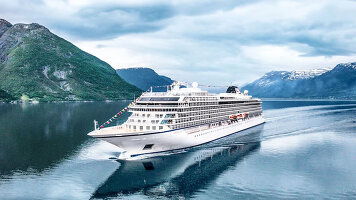
Launched in 2018, the Viking Orion is an all-veranda ship, part of a fleet of award winning, state of the art ships incorporating all the comforts & luxuries you would expect from Viking. Read more
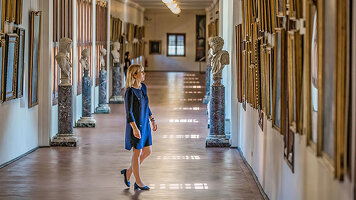
Viking are destination experts. With no casinos or children on board, you can be assured that the focus is firmly on enrichment and education. Read more
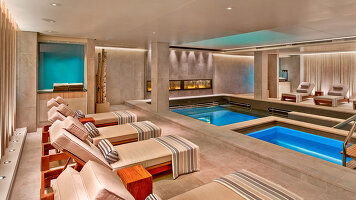
After a day of exploration or just to enhance the relaxation of a day at sea, the on-board Spa will leave you feeling recharged and revitalized. Read more
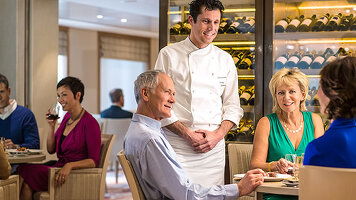
Viking offer eight on board dining options. Beer, wine and soft drinks are available with lunch and dinner at no additional charge of fee. Read more
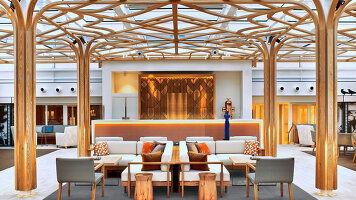
Viking proudly includes all that you need and nothing you do not. A variety of features and services valued at $200 per person per day are standard inclusions in your cruise. Read more
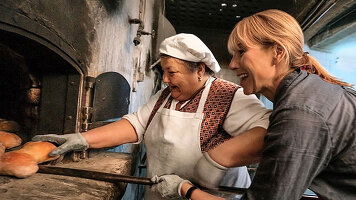
Viking include one complimentary shore excursion in every port of call. Enjoy exclusive entry to cultural treasures and seldom-seen collections around the world. Read more

Trip Reviews (7) View All Most Recent 'Australia, New Zealand & Indonesia' Reviews
Stops we particularly liked were Icy Strait Point, Sitka and Ketchikan. Haines was a disappointing stop as there's really nothing to do there and the "famed" Raptor Centre turned out to be a few sad bald eagles in very small cages and lots of stuffed wildlife specimens. Skagway would have been preferable. Wildlife sightings didn't happen - but the weather was perfect - so you can't have everything! Hubbard Glacier was also good - although a long day in fog to get to actually see the mammoth glacier! Finishing in Vancouver was great as it meant just one flight home - instead of the 2 to get to Anchorage and the reasonably long transit between which made for a very long start to the trip. Thanks Jemma - talk soon again...about our next travels!!
Viking Orion was a magnificent ship having everything included (except spa) made for a relaxing cruise. Crew were fantastic and food exceptional. Japan was wonderful with plenty of time to take read more in the culture and beauty. Scenery and wildlife in Alaska was spectacular although we were disappointed that 3 excursions were cancelled and some ports visits were short. The shuttle buses provided by Viking made it an ease to go downtown and we always got a warm welcome back! Crossing from Japan to Alaska, 7 days at sea was a bit long for us. Extension of Vancouver we would have been better to have done on our own. We made incredible friendships we would definitely cruise with Viking again and book with Georgie at Global Journeys. Big thanks 🌺
We really enjoyed the high quality of the food and we especially liked being able to book into the fine dining "Chef's Table" or the Italian "Manfredi's restaurant" if we pleased (available to all at no extra charge). A real highlight for me was participating in a French cooking lesson with 11 others. It was run by one of the chefs on the cruise. We also appreciated the talks given by the resident historians and specialists on board.
We certainly would book another cruise with Viking - in fact we have already done so! Jemma at Global Journeys was excellent. She responded to any enquiries relating to the trip very promptly and ensured all paperwork was in place in a timely manner. Thank you Jemma.
Download Brochure
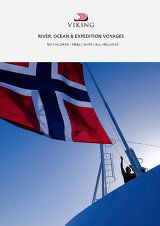
Viking River, Ocean & Expedition Voyages (2025-27)
Dates & Pricing
 USD
USD
Viking Cruise $25 Deposits!
Cabin Layout Options:
Select Cabin Preference:
Tour & cruises prices are per person. Prices shown have savings applied, are subject to availability and may be withdrawn at any time without notice. Pricing and trip details are correct at this point in time, however are subject to confirmation at the time of booking and are subject to change by Viking. For cruise itineraries, cabin images are sourced from the cruise-line and should be treated as indicative only. Cabin inclusions, upholsteries and room layout may differ to the image(s) shown depending on the ship selected and your sailing dates.



